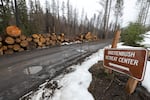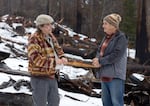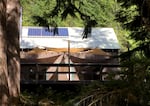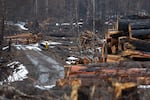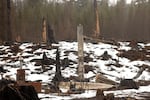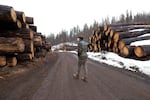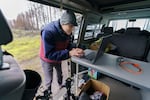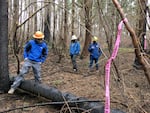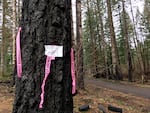Jon Haas counts more than 150 rings in one of the many logs lying on the side of the road to Breitenbush Hot Springs.
“There’s some even bigger ones farther up,” he said. “I’ve never seen trees like this come down.”

Jon Haas, finance director for Breitenbush Hot Springs, tries to count the rings on one of the smaller logs that have been cut and now line Hwy 46 on the way to Breitenbush, March 5, 2021.
Kristyna Wentz-Graff / OPB
He’s standing alongside one of the massive log decks that line both sides of the road near Detroit where the U.S. Forest Service has cut down “danger trees” that burned in the Lionshead Fire. The logging was so extensive that the area has become unrecognizable — even to Haas, who lives at Breitenbush and works at the retreat and conference center as its finance director.
“I’ve been up and down this road hundreds and hundreds of times,” he said. “And I thought I was on the wrong road. Maybe I took a wrong turn or took the wrong fork...I was so dependent on these trees as my landmarks.”
The logging took place while the area was closed to public access, and there was no notice that it was happening. So, the massive log decks came as a shock to people who live in the area and own cabins on Forest Service land at Breitenbush. But the Forest Service says that’s how the rules work with the removal of dangerous trees after a wildfire.
Haas said he understands the need for safety and doesn’t want trees falling on Breitenbush guests, but he’s wary of excessive post-fire logging and the emergency rules that allow it to happen with reduced levels of environmental scrutiny.
“There are laws on the books that allow them in situations like this to extract lumber that doesn’t need to be extracted, and that is a thing we’re worried about and that we don’t want to see happen,” Haas said. “At what point is the fire being used as an excuse to extract lumber that could not otherwise be extracted?”
Chainsaws are buzzing across more than a million acres of Oregon that burned in wildfires last year, and they’re moving fast under post-wildfire logging rules that allow more trees to be cut with fewer restrictions and short notice, if any, to the public.
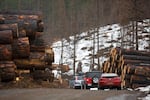
Cars travel along Hwy 46 on the way to Breitenbush, a place known for the large and lush forests, but has now been heavily logged following the Beachie Creek and Lionshead fires in 2020.
Kristyna Wentz-Graff / OPB
“There is an incredible amount of logging happening right now,” said Nick Cady with Cascadia Wildlands, an environmental group that often fights logging projects. “We’re just kind of scrambling...the extent of roadside logging is above and beyond anything we’ve ever seen, and we were left without recourse because there was no public comment. We didn’t even know the extent of it.”
It’s not just along roads, where public safety is the top concern. Extensive salvage logging proposals on federal and state forestland are raising concerns from people who want to see those forests recover naturally and, in many cases, don’t have access to the burned forest to see the condition of the trees proposed for logging.
Environmental advocates have asked Oregon’s congressional delegation to halt proposed logging projects on about 10,000 acres of federal land that burned in the Holiday Farm and Archie Creek fires, arguing land managers should let more old-growth trees stand and avoid the soil erosion, water pollution and wildlife habitat degradation that can result from logging burned forest.
Flashback to the timber wars
The Breitenbush community was at the heart of Oregon’s timber wars in the 1980s. It’s now surrounded by cut logs, both on the road and in an area where more than 70 cabins used to be shaded by a canopy of trees in the Willamette National Forest.
Cabin owners were barred from entering the area after the fire destroyed all but one of the cabins last September. When they were allowed back in to survey the damage, they were stunned by the extent of the logging surrounding the burned cabins.
“The logging was just mind-blowing,” said Jay Hennigan, president of the Breitenbush Cabin Owners Association. “And they had already been doing that for some time before they even let us know.”
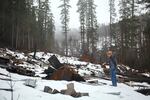
Jay Hennigan, president of the Breitenbush Cabin Owners Association, looks at some of the rubble remaining where his cabin once stood in Breitenbush, March 5, 2021. The cabin was destroyed by the Beachie Creek and Lionshead fires in 2020.
Kristyna Wentz-Graff / OPB
The cabin he used to own is now a pile of rubble on a burned, logged and barren landscape. Wildfire destroyed both his cabin and his home in the nearby town of Gates.
“Initially we were told that no one was going to be allowed in this area at all for clean up, logging — nothing,” he said. “They were just going to let nature do its thing.”
Then the Forest Service changed course, allowing the cabin area to be logged so that cleanup crews could safely remove hazardous waste from the burned structures. The agency isn’t required to notify the public of emergency danger tree removal, but the agency did inform the cabin owners of the logging after it had begun.
Hennigan said the cabin owners asked repeatedly if they could access the area under Forest Service supervision to see what trees were being cut, but their requests were denied.
“There was some concern amongst the cabin owners that the Forest Service was being too aggressive and cutting down trees that didn’t need to be cut down,” Hennigan said.
Hennigan said communication with the Forest Service has improved recently, and he doesn’t think the cabin owners could have changed the outcome for the trees in the cabin area. But it did spark some flashbacks for Breitenbush cabin owners who fought the timber industry in the past to stop clear-cuts.
Related: OPB's 'Timber Wars' podcast
“This incident stirred up a lot of memories of people who have been through the timber wars,” he said. “Like, ‘Oh, the Forest Service has got an excuse to do some logging, and they’re going to just, you know, rape the entire forest, for dollars.’”
Which burned trees should be logged?
One bedrock principle of U.S. environmental law is that citizens have the right to challenge proposals to log, mine, develop or pollute. But that’s become almost impossible during Oregon’s wave of post-wildfire logging.
Federal rules make it easier to log after wildfire through “categorical exclusions” that speed up the environmental review process for salvage logging with the goal of reducing safety risks and allowing burned timber to be sold before it rots.
Cady said that makes it harder for groups like Cascadia Wildlands to challenge post-wildfire logging proposals on U.S. Forest Service and Bureau of Land Management land.
“It’s hard to challenge because they just happen fast and you can’t organize a lawsuit,” he said. “You have no idea it’s happening until it’s too late. There’s 15 days notice prior to implementation.”
Plus, many of the burned areas are closed to the public, so it’s hard to verify whether the trees are so badly burned they really need to be logged.
Ralph Bloemers, who works with the Crag Law Center as an advocate for natural wildfire recovery and fire-safe communities, wanted to know just how burned the trees are in an area proposed for salvage logging on the Santiam State Forest.
The area is closed to the public, so he decided to use a drone to get around — literally, to get above — that restriction. He flew a camera-equipped drone to see for himself what the trees look like in the Monument Peak area, where the Oregon Department of Forestry has proposed timber sales on about 200 acres of burned land.

Ralph Bloemers has been documenting the areas affected by the 2020 Santiam wildfires. He retrieves a drone after photographing a heavily burned area, Feb. 26, 2021, and will compare the images to those he shot previously see how the area is recovering.
Kristyna Wentz-Graff / OPB
“Oh my gosh, it’s unreal,” he said, looking at the drone camera monitor. “It’s like all green.”
Bloemers says the trees with green tops don’t need salvage logging because they’ll recover naturally and offer great wildlife habitat.
“Salvage suggests making something good out of a bad situation, but this isn’t a destroyed place,” he said. “Clearly, this is an area that is still very green. We hear the birds chirping. It’s full of life.”
Standing in that same area on the ground, though, Kyle Kaupp with the Oregon Department of Forestry pointed to a section of trees that were small and scorched. He said these are the trees that will be logged and replanted, as evidenced by the neon pink “timber harvest” flagging posted on their bark.
“They’re not green anymore,” he said. “It’s a stand of dead trees and, you know, safety hazards pretty much.”
But Kaupp said his agency is also protecting viable trees. He pointed to an older stand of trees nearby with quite a bit of green left in them. After seeing that stand from the ground, he said, the agency decided not to log there and removed it from its salvage logging plans.
“We do think that not doing anything here is probably the quickest way to restoration and forest health,” he said.
ODF has a controversial plan to log about 18% of the 16,600 acres burned in last year’s wildfires.
“We’re trying to find that middle-of-the-road path to maintaining and restoring a healthy forest out here. And you know, the middle of the road is a hard place to be.”
Oregon Sen. Fred Girod, R-Stayton, told the Oregon Board of Forestry to remember the value of the timber industry and the communities surrounding state forests as they’re finalizing post-wildfire logging plans.
”Timber money is extremely important to these communities,” he said. “I can’t stress that enough.”Girod said he blames poor forest management for the wildfire that burned down his house and believes more logging is needed to guard against future wildfires.”
To say I’m a little bit upset about it is an understatement,” he said. “And the board is considering all these different small factors. But the one you’re leaving out is the people that had their homes destroyed and what they think. They want to make it so it’s safe from fire.”
Department of Forestry spokesman Jason Cox says the agency plans to leave as many green trees standing as possible. But environmentalists have threatened to sue the state because its post-wildfire logging plans include some older stands of trees that are supposed to be reserved for wildlife habitat.
Meanwhile, timber advocates and nearby counties are calling for more logging to support local economies and reduce the risk of future fires. Cox said he’s not expecting everyone to agree on which burned trees to cut and which ones to leave standing.
“We’re trying to find that middle-of-the-road path to maintaining and restoring a healthy forest out here,” Cox said. “And you know, the middle of the road is a hard place to be.”

